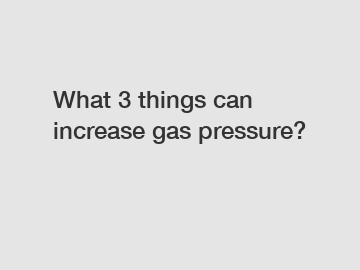Jan. 23, 2024
Tools
What 3 Things Can Increase Gas Pressure?
Gas pressure refers to the force exerted by a gas per unit area. It is an essential concept in understanding various phenomena related to gases, from weather patterns to the operation of engines. Understanding the factors that can increase gas pressure is crucial for a wide range of industries and scientific fields. In this article, we will explore three key factors that can lead to an increase in gas pressure.
1. Temperature.

The temperature of a gas plays a significant role in determining its pressure. According to the ideal gas law, as the temperature of a gas increases, its pressure also increases, provided the volume and the number of particles remain constant. This relationship is known as Charles's law, which states that the volume of a gas is directly proportional to its temperature. When the temperature of a gas increases, the average kinetic energy of its particles also increases, causing them to collide with the container walls more frequently and with greater force. As a result, the gas molecules exert a greater pressure on the container, leading to an increase in gas pressure.
2. Volume.
The volume of a gas is another important factor that can influence its pressure. According to Boyle's law, the pressure of a gas is inversely proportional to its volume, provided the temperature and the number of particles remain constant. When the volume of a gas decreases, with the temperature and the number of particles remaining constant, the gas molecules have less space to move around, resulting in more frequent collisions with the container walls. These collisions exert a higher pressure on the walls of the container, leading to an increase in gas pressure.
3. Number of Particles.
The number of gas particles also affects the gas pressure. This relationship is described by Avogadro's law, which states that, at constant temperature and pressure, the volume of a gas is directly proportional to the number of particles. When the number of gas particles increases, while the temperature and the volume remain constant, the gas molecules have less space between them, leading to more frequent and forceful collisions with the container walls. Consequently, the gas pressure increases.
In summary, three primary factors can increase gas pressure: temperature, volume, and the number of particles. When the temperature of a gas increases, its pressure also increases, provided the volume and the number of particles remain constant. Similarly, when the volume of a gas decreases, with the temperature and the number of particles held constant, the gas pressure increases. Finally, an increase in the number of gas particles, while maintaining constant temperature and volume, leads to a higher gas pressure.
Understanding these factors is crucial for various fields, including chemistry, physics, and engineering. In industries such as oil and gas, chemical manufacturing, and refrigeration systems, a comprehensive understanding of gas pressure enables engineers and technicians to design safe and efficient processes. Additionally, meteorologists rely on the principles of gas pressure to predict weather patterns accurately.
If you have any questions or would like to learn more about gas pressure, feel free to contact us. Our team of experts is here to provide you with the necessary information and assistance you may need.
For more information, please visit c02 gas pumps, oxygen gas booster, pressure pump air tank.
Previous: What is the strongest socket with the highest tightening force?
Next: Maximize Efficiency & Power with Boost Air Compressors: Your Ultimate Guide!
If you are interested in sending in a Guest Blogger Submission,welcome to write for us!
All Comments ( 0 )